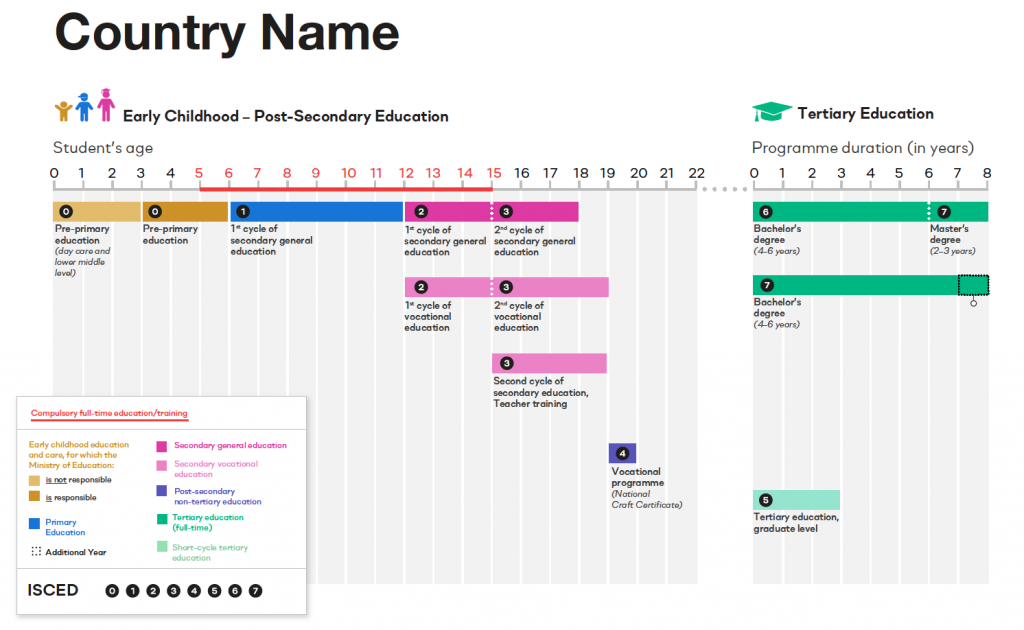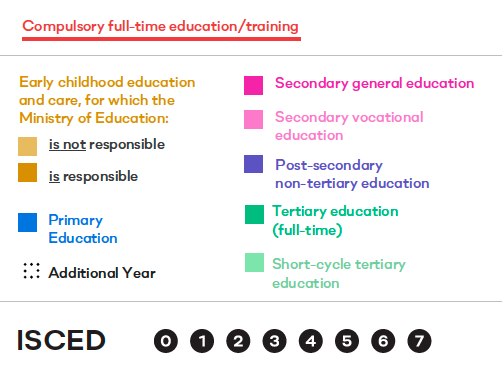Reading the diagrams
Main elements:
The diagrams are based on the age of students and programme duration, and the level and type of education.
Age of students and programme duration scales:
Student age: The student age scale indicates the age of pupils and students when they start each level of education from pre-primary through to non-tertiary vocational education (ISCED levels 0 to 4). These ages are theoretical and give an indication of the official age at which children might begin early childhood education or compulsory education. Early or late entry, grade retention or other interruptions to schooling, and adult learning are not taken into account.
Programme duration: The programme duration is indicated by the length of the bars. For primary, secondary and vocational education duration is implied by student age in years which is indicated on the scale at the top of the diagram. For tertiary programmes, the scale is based on the duration of the programme in years, from zero to eight. The duration of part-time studies or individualized study patterns are not available in these diagrams.
Levels and types of education:
The coloured bars of the diagrams show national education system programmes with different colours representing the different levels and types of education. Separating each coloured bars, solid white vertical lines show the division of each level of education. A dotted white line within the same coloured bar depicts the continuation of a programme to the next level. A black dotted box indicates that an additional year of the programme is available. The ISCED level is indicated by the number in the black circle on each bar.
Graphic representation:

Early childhood and post-secondary education (left hand side of the diagram):
The coloured bars on the left depict the main educational programmes from pre-primary to post-secondary non-tertiary levels (ISCED levels 0 to 4) in relation to the age of students when they start a particular programme. The ages indicate the theoretical age at which students are supposed to enter an education level in that country or begin a study programme. (Early or late entry, grade retention or other interruption to schooling are not taken into account.)
Order of representation in the diagram from left to right:
- Pre-primary
- Primary
- Secondary
- Post-secondary non-tertiary vocational
Tertiary education programmes (right hand side of the diagram):
The coloured bars on the right show the main programmes at the tertiary level in relation to the standard number of years necessary to complete these programmes on a full-time basis. The duration of part-time studies or individualized study patterns are not presented.
Order of representation in the diagram from top to bottom:
- Bachelor’s degree/programme
- Master’s degree/programme and specialization
- ISCED 6 Bachelor’s degree/programme in specialized studies
- ISCED 7 Bachelor’s degree/programme in specialized studies
- Short-cycle tertiary education
If a programme requires the certification of another tertiary education programme for its entry, they are placed next to each other.
Tertiary education programmes are ordered from left to right as follows:
- Programmes that require ISCED 4 or less for admission (usually a Bachelor’s degree or short cycle tertiary programmes) are placed in the “0” axis position.
- ISCED 7 programmes for which entrance requirements include certification of ISCED 5 or 6 programmes for entry are positioned at the final year of those programmes based on their theoretical duration, separated by a vertical white line.
- The same criteria are used for all tertiary education programmes that have another tertiary education programme completion certificate as an entrance requirement.
- If the country has Bachelor’s degree programmes with different theoretical durations, the ISCED 7 bar is positioned at the end of the lowest theoretical duration of those levels.
Legends used to standardize the display of information:

Additional year: This dotted box (as seen in the legend) is used to indicate the cases where the duration of an education programme has a variable theoretical duration. For example, in cases where an education programme has a part that does not need to be completed to finalize a cycle of level of education, but may be necessary to access a higher level of education or move on to a different path.